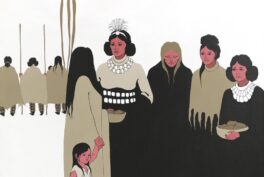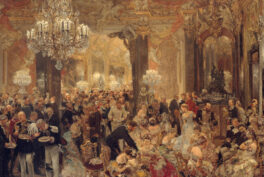What’s the popular version of Thanksgiving?
The story many Americans learn in school tells of a hopeful beginning in 1620, when a group of English Pilgrims arrived at Plymouth Colony, in what is now Massachusetts. After enduring a harsh winter, they were met by a friendly Native American tribe, often identified as the Wampanoag people. According to tradition, these Native Americans welcomed the Pilgrims to the New World, teaching them essential survival skills like how to grow corn, gather food, and live off the land. They showed them techniques for farming, fishing, and hunting that were vital for survival in the unfamiliar territory. In this version of Thanksgiving, the Native people also generously provided land to the Pilgrims, helping them establish their homes.
Then, as the story goes, in the fall of 1621, the Pilgrims and the Wampanoag came together for a grand feast to celebrate the Pilgrims’ first successful harvest. This three-day gathering is said to have included traditional dishes like wild fowl and local vegetables, marking the first Thanksgiving. Over tables full of shared dishes, both groups supposedly joined in harmony, symbolizing a hopeful beginning of friendship, peace, and mutual respect. And, as the story often implies, they all lived happily ever after.
In reality, this widely accepted version is a whitewashed account of the real history of Thanksgiving. Most people learn that Native Americans willingly handed over their land to European settlers, facilitating the creation of a nation rooted in liberty, opportunity, and Christian values. This sanitized version implies that Native Americans passively accepted colonialism, all for the benefit of future generations.
The real history of Thanksgiving
The actual events behind Thanksgiving paint a very different picture. The Pilgrims arrived at Plymouth Colony in 1620, where they faced a devastating winter. They suffered from fever, hunger, and harsh conditions, with many, especially women, losing their lives. One day, after a group of around 50 colonists went hunting, they began shooting in celebration. The noise alarmed the Wampanoag sachem, or chief, Massasoit, who sent nearly 90 of his men to investigate. When they met the Pilgrims, there was no immediate hostility, despite the fact that the settlers had previously stolen winter provisions from the Native Americans. Massasoit offered an alliance to the colonists—not out of friendship, but as a strategic move to protect the Wampanoag from rival tribes, particularly the Narragansetts.
This alliance led to a celebration that the Pilgrims later marked as a day of Thanksgiving. However, this occasion was less of a feast and more of a religious observance, involving prayer and fasting to thank God for their survival. Though popular lore suggests that the Pilgrims invited the Wampanoags to join the celebration, there is no concrete evidence to support this claim; in fact, it’s likely that the Native Americans weren’t invited at all.
This uneasy treaty lasted nearly 50 years, but it was repeatedly tested as colonial expansion encroached on Wampanoag land. The arrival of thousands of new settlers, the spread of deadly diseases—particularly an epidemic known as “Indian fever” that decimated half of the Native population—and the relentless demand for resources put strain on the alliance. Gradually, colonial authorities asserted control over many aspects of Wampanoag life, pushing the tribe into an increasingly subordinate position.
King Philip’s War
When Metacomet—Massasoit’s son, known to the English as King Philip—became leader of the Wampanoag, relations with the colonists had already deteriorated. Tensions had been mounting for years, driven by the encroachment of English settlers onto Native lands, increasing colonial demands for control, and the unfair treatment of Native peoples. The Wampanoag, already weakened by disease and land loss, were further provoked when many of their men were executed under English laws. In retaliation, Metacomet led a series of raids on colonial settlements, aimed at pushing back against the encroaching settlers and defending his people’s land.
In 1675, the New England Confederation of Colonies declared war, igniting what became known as King Philip’s War, or the Great Narragansett War. This brutal conflict was marked by fierce battles, widespread destruction, and significant loss of life on both sides. The war devastated the Native American population, with entire villages destroyed and many Natives killed or enslaved. Metacomet’s tragic end came in 1676, when he was captured, beheaded, and his head displayed by the colonists as a grim symbol of their victory.
These painful events have largely been overlooked in mainstream narratives of Thanksgiving. For many Native Americans, the day is now observed as a National Day of Mourning. They gather to remember the lives lost and reflect on the consequences of colonization. As many have expressed, they regret that the Pilgrims were ever allowed to settle on their land.
Was this the first Thanksgiving?
Berkeley Hundred
Opinions differ on whether the first Thanksgiving actually took place at Plymouth. Evidence suggests it may have happened elsewhere. For example, in 1619, English settlers arrived in Berkeley Hundred, now part of Virginia, and held a celebration upon their arrival. These settlers traveled on the Margaret, a small ship that took nearly three months to cross from Bristol, England, to the Berkeley Plantation. The journey was harsh, with food running low. Unlike other Virginia settlers, this group didn’t come to profit from tobacco but was instead motivated by strong religious beliefs.
After this difficult voyage, they landed on the shores of the James River. Their captain, John Woodlief, led them in a prayer of thanks for their safe arrival. The other settlers knelt in prayer beside him, grateful to God. No Native Americans were present. This Thanksgiving was purely about prayer and gratitude. Though they may have eaten oysters and ham, this simple meal was out of necessity, not celebration. The Berkeley Company had instructed Captain Woodlief to mark this day each year as a holy occasion. For the next few years, they kept this annual Thanksgiving tradition.
By March 1622, however, tensions with the Powhatan tribe had risen. The Powhatan saw that the settlers were likely to expand and attempt to “civilize” them. In response, they attacked Berkeley Plantation and other nearby settlements, killing many settlers. Captain Woodlief survived, but Berkeley Hundred was abandoned for nearly three centuries, and Virginia’s first Thanksgiving was largely forgotten.
St. Augustine
One of the earliest Thanksgiving celebrations in what is now the United States happened in 1565, long before the Pilgrims set foot in Plymouth. Spanish explorer Pedro Menéndez de Avilés, who had just founded St. Augustine, Florida—the oldest continuously inhabited European-established city in the U.S.—held a mass to thank God for his crew’s safe arrival.
Afterward, he invited members of the local Timucua tribe to join him and his crew for a meal. The event likely included Spanish dishes like salted pork, garbanzo beans, and hard sea biscuits, paired with Timucuan foods such as maize, squash, and beans. This gathering represented a brief moment of peace between the Spanish settlers and the Timucua, whose culture and presence in Florida spanned thousands of years. Though often overlooked, this 1565 celebration is recognized by many historians as one of America’s first recorded Thanksgivings.
Massachusetts Bay
In 1637, Massachusetts Bay Colony Governor John Winthrop declared a Thanksgiving day to celebrate a brutal victory. Colonial soldiers had recently killed hundreds of Pequot men, women, and children near present-day Mystic, Connecticut. This violent attack became known as the Pequot Massacre, marking one of the earliest and most tragic Thanksgiving observances in American history.
Establishing Thankgiving celebrations
Abraham Lincoln officially established Thanksgiving as a national holiday. In 1863, in the midst of the Civil War, he proclaimed a national day of Thanksgiving to be celebrated each year on the last Thursday of November. This tradition continued with only a few exceptions. Nearly 80 years later, in 1942, Franklin Roosevelt issued a new proclamation. He designated the fourth Thursday of November as the Thanksgiving holiday, which sometimes falls before the last Thursday of the month.
Thanksgiving, as many know it, hides a complex and often brutal history. The real history of Thanksgiving is deeply tied to colonialism and the tragic mistreatment of Native Americans, including the violent Pequot Massacre and the conflicts that followed. While Thanksgiving has become a time for family and gratitude, it’s also important to remember the experiences of Native communities who faced loss and upheaval as European settlers arrived.
For those who want to honor this history, consider learning more about Native American cultures and the impact of colonialism. Many people observe the holiday by supporting Native organizations, reading Native authors, or acknowledging the lands they live on. By doing so, we can expand Thanksgiving’s meaning, making it a day of gratitude that respects both history and resilience.












